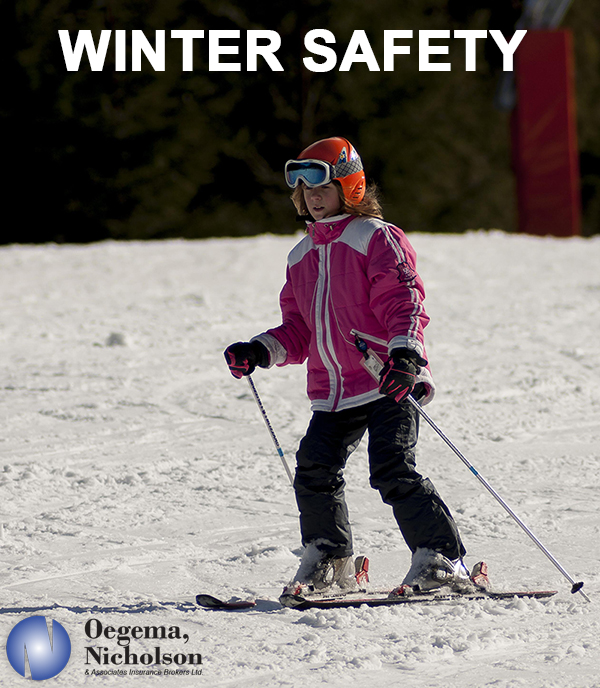25 Tips to Avoid Injury and Peril this Winter
Winter’s here, and once it gets a little cooler in Eastern Ontario, most of our traditional Canadian winter activities will kick in to full gear. Whatever activities you like doing in the winter, follow these guidelines to ensure that it’s a safe one for you and your family. 
General
1. Keep an eye out for black ice on sidewalks. It often just looks like water on a sidewalk or road, or is barely visible.
2. Take responsibility for the sidewalk in front of your home and clear it of ice whenever possible.
3. Spread salt, sand or an ice melter on slippery walks, porches and driveways
4. It’s easy to injure yourself while shoveling snow, particularly when the snow falling is wet and heavy. Try to shovel right away so that it doesn’t get packed down, which, as all Canadians know, makes it a much more difficult and strenuous task.
5. Keep your hands out of your pockets in icy conditions for better balance.
6. Leave a little bit of extra time if you’re walking somewhere, to avoid situations where you have to walk faster than is safe.
Snowmobiling
Many people in Eastern Ontario enjoy snowmobiling as a winter hobby. Keep these pieces of advice in mind to ensure your safety on the trails. 7. Never take the chance that ice is thick enough to ride on. Err on the side of caution – snowmobiles are very heavy machines. Here’s a good
guide to identifying ice thickness. 8. Make sure your recreational vehicle is properly
insured through a trusted broker, and be aware of what your policy covers.
9. As with driving a vehicle, alcohol severely impairs judgment and should not be consumed under any circumstances.
10. On longer trips, make sure you have a friend riding with you in case your snowmobile breaks down.
11. Check on the trail conditions before heading out.
12. Ensure you’re appropriately dressed before setting out on your trip.
Skiing & snowboarding
13. Don’t overestimate your abilities. Choose an appropriate hill for your skill level.
14. Only stop in a place that’s safe for both yourself, and other users on the hill.
15. Look uphill before merging in or starting a run to make sure there’s no one barreling down towards you.
16. As with any other highly physical activity, a proper warm up will reduce the chance of a muscle injury.
17. Ensure you have water on hand to avoid dehydration, particularly while cross-country skiing.
Skating
In this area, we’re lucky to have access to great outdoor skating lakes, ponds, and of course, the Rideau Canal in Ottawa. 18. Remember that helmets should be worn during any skating activities, and especially ‘natural’ ice surfaces – where the ice is much more likely to contain bumps and cracks. Even a highly experienced skater can wipe out badly from hitting an unexpected rut in the ice.
19. See the link in the snowmobiling section for tips on how to ensure that the ice is thick enough to be on. Again, don’t take any risks when it comes to that, as the results could be disasterous disastrous if it breaks.
Sledding/Tobogganing
20. It’s a rite of passage for children in Eastern Ontario to go sledding each winter. But accidents can cause serious injuries. Here are a few tips to keep your kids safe.
a. Ensure that there’s lots of room to safely stop the toboggan at the bottom of the hill.
b. Children should wear a helmet that’s approved by the CSA when tobogganing.
c. Sledders should not go downhill head first; always sitting or kneeling, facing forward;
d. Most tobogganing injuries occur in poor light conditions, so keep your sledding activities to the daylight hours.
21. For a more extensive list of safety tips, visit the city of Ottawa’s
Tobogganing and sledding safety tips.Driving and Road Safety
22. Check out our previous post on
safe driving during the winter season for a full list of helpful hints and advice. Here are some of the main points:
23. Winter tires are important to have in Eastern Ontario and can be a huge help in icy conditions – according to the Insurance Bureau of Canada, proper snow tires can reduce stopping distance by 40 per cent.
24. Make sure you have your winter driving emergency kit prepared and in the car at all times, in case you end up needing it.
25. Take a few minutes to ensure that all snow is off your car before heading out. Blowing snow can be a visibility hazard for you, and other drivers. From everyone at Oegema, Nicholson & Associates, have a wonderful holiday season, and a great new year. Enjoy the winter, and Happy Holidays! Thanks for reading,
The ONA Team.



